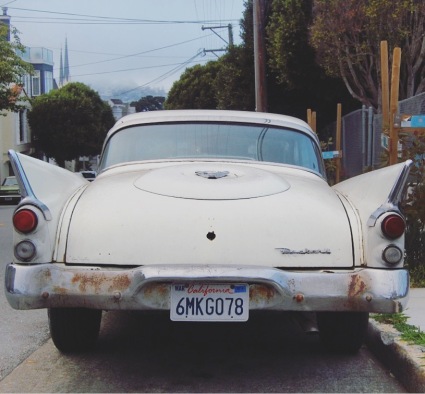 Desperate times call for desperate measures. Fewer post-war manufacturer moments represented Code Red better than the reality of the Studebaker-Packard merger of 1954. In the imperfect marriage between the pearl of South Bend and once the most exclusive brand in the land of The USA saw a monumental undoing rather hastily. The debacles of Studebaker’s quality failings and poor ability to keep up with consumer demand of their 1953 coupes had long lasting implications. Packard’s own quality difficulties sunk their Clipper ships and their larger cruise ships.
Desperate times call for desperate measures. Fewer post-war manufacturer moments represented Code Red better than the reality of the Studebaker-Packard merger of 1954. In the imperfect marriage between the pearl of South Bend and once the most exclusive brand in the land of The USA saw a monumental undoing rather hastily. The debacles of Studebaker’s quality failings and poor ability to keep up with consumer demand of their 1953 coupes had long lasting implications. Packard’s own quality difficulties sunk their Clipper ships and their larger cruise ships.
It’s perhaps fitting irony that one of the final Packards offered were a variation on the latest update of the ill-starred Starlight coupes of 1953. What made this Packardbaker so special?
 Given that there were already mountainous budget constraints, there was little Studebaker-Packard could do to make the Clipper and Hawk models all that much more different from the Studebaker Presidents and Golden Hawks they were based upon.
Given that there were already mountainous budget constraints, there was little Studebaker-Packard could do to make the Clipper and Hawk models all that much more different from the Studebaker Presidents and Golden Hawks they were based upon.
In the Hawk’s case it seriously came down to a fiberglass nose job, external leather armrests (which are missing from our streetside example) and a “continental kit” trunk lid. Gold inserts (also missing from this example) hung out in the coves carved by the arc of the tailfins.
 On the inside a full leather interior and full instrumentation reflective of the expensive speed boat ethos of this Packard Hawk were included.
On the inside a full leather interior and full instrumentation reflective of the expensive speed boat ethos of this Packard Hawk were included.
These “improvements” were layered upon the already pricey Golden Hawk 400 available at Studebaker showrooms. Still optional however, for the lofty price tag of nearly $4,000 were power windows and seats.

The styling changes were questionable additions that were layered upon updates that were already questionable, given the design purity of the original 1953 version of the design. Nor did the updates rectify some serious shortcomings of the underlying Starlight/Hawk design.
Nevertheless, with Packard 352 V8 that powered the initial Golden Hawk being replaced with the lighter supercharged version of the Studebaker 289 V8 made for sprightly performance. Aiding in straight line performance was a limited slip differential.

However, underneath it all was a now 6 year old design with the same willowy, flexing frame and propensity for rust. If it weren’t bad enough that the Hawk was one of the earliest examples of badge engineering out of desperation, the flawed original versions of this extension of credibility still rolled America’s highways.
This was sold against the freshness that was the 1958 Ford Thunderbird, now available in hardtop coupe and convertible models. The Thunderbird offered personalized luxury for 4 passengers in a more stereotypically overwrought Detroit design package at a less dear price from a manufacturer not under suspicion of going under at any moment.

These numerous factors, aided by the Eisenhower Recession that saw just about all manufacturers take a productivity hit in 1958, conspired to make this Hawk on of the most rare birds from an American Manufacturer that year. Only 588 examples were sold before Studebaker turned off the lights on America’s once most prestigious brand.
This also makes the rarity of this bird on the streets of San Francisco all the more fascinating. Through the misty fog, we see one rare ghost of America’s quality past, perhaps telling us of how to prevent further downfalls in our present. There’s no need to hide our truths about the weak foundations we find ourselves resting upon with remodels of an outmoded way of being. Sometimes it’s best to throw in the towel, and start from fresh.
A perfect storm of Nope!
I like a lot of oddball cars, but other than sheer rarity, the only thing positive I can come up with is that those are pretty nice wheel covers & the whitewalls are a lot cleaner than that 60 Plymouth from the other week.
You honestly have to wonder how they sold as many as they did. And how long did it take?
LikeLike
Yeah, it’s a 1958 case of “Who Did This?” files. I’ve always preferred the finless Loewy coupes (1953-55 and the GT Hawks). But all of the changes to make the already pushing it Studebaker versions do these no favors. It’s a good question of how they managed to move so many of them, especially at such a high price.
LikeLike
You’d have to ask the man who owned one.
LikeLike